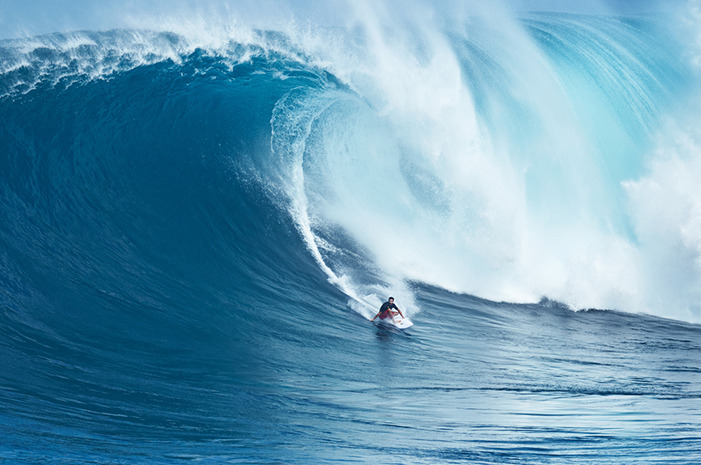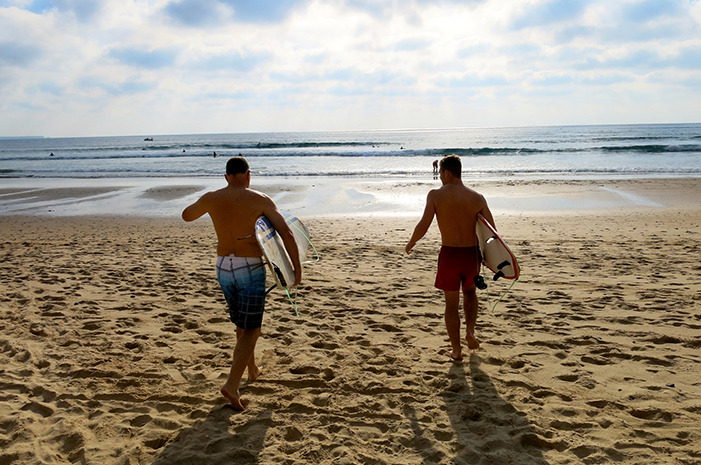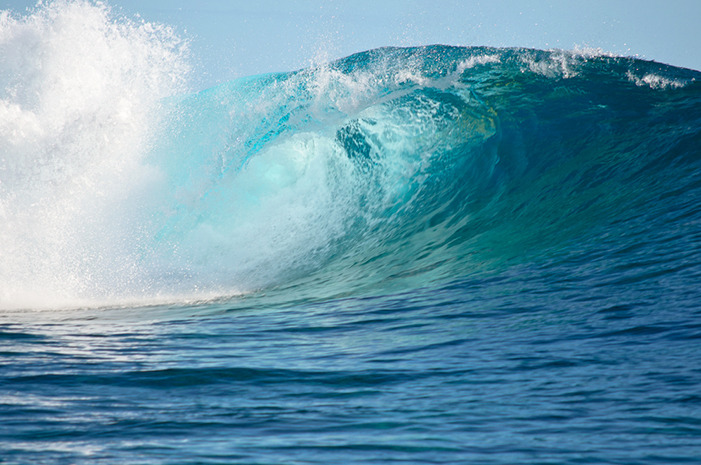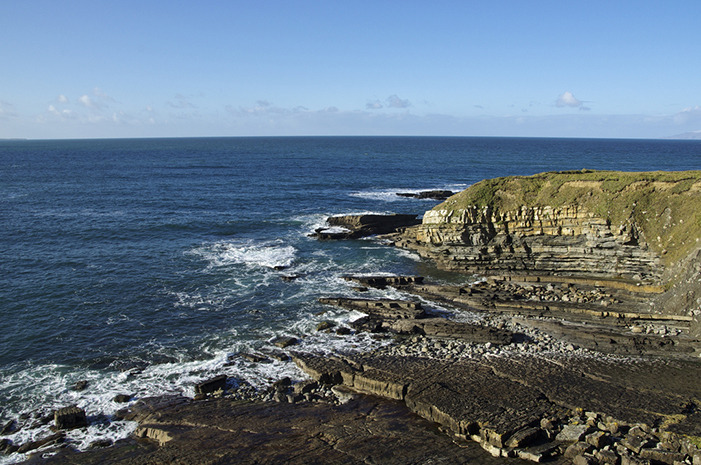The World's Best Beaches For Big Wave Surfing
1. Jaws- Pe'ahi, Maui, Hawaii
As you may have guessed, Jaws got its name from the terrifying shark thriller. Big wave surfers here use tow-in methods in the water. Most of them are launched by Maliko Bays boat ramp, and towed in to avoid the steep climb as well as extremely fast moving waves. Jaws Peahi is the location of the Red Bull Jaws contest, a surfing contest held for 21 of the best and most daring big wave surfers in the world.
2. Nazare, Portugual
Also known as "Portugal's Monster" Nazare is the home of some of the most enormous waves in the world. Garrett McNamara set the world record in 2011 for the biggest wave ever surfed at 78 feet. "In Nazare," the Hawaiian surfer told Time, "the ocean is known as a place of death, not of riding waves" (npr.org). Nazare's waves are created much larger due to the Nazare Canyon. They are so dangerous that big-wave surfer Maya Gabeira was nearly killed during a wipeout in 2013.
3. Teahupo'o- Tahiti, French Polynesia
According to Grind TV, Teahupo'o is the most dangerous break in the world. "The waves there have a unique combination of size, power and speed made more dangerous because they break over a sharp coral reef lying only meters below the surface." In one of the first competitions held in Teahupo'o, the contest boat carrying the judges and marshals was struck by a wave and capsized.
4. Ghost Tree- Pebble Beach, California
Pebble Beach is a resort destination, and home to one of the best beaches for big wave surfing, Ghost Tree. Ghost tree got its name because months can go by and you would never see a wave, then out of nowhere, a powerful wave will appear. Professional big wave surfers risk their lives waiting patiently at Ghost Tree just to catch the right wave. Once they do, the adventure begins, and they launch the ride of their life. Surfer Peter Davi died in a massive wave at Ghost Tree in 2007.
5. Cortes Bank- Cortes Bank, Calif
Cortes Bank is located in the Northern Pacific Ocean and is the home of Bishop Rock. Bishop Rock is considered one of the best spots for big waves. In 1961 Harrison Ealey received tremendous admiration for being one of the first people to surf a wave there.
6. Pedra Branca, Tasmania, Australia
Pedra Branca is a small island located on the southern coast of Tasmania and is the home to a huge wave surf break. They are known for their extreme weather conditions, large waves and variety of marine wildlife. In 2003 Hamish Saunders was literally swept off of Pedra Branca; a deadly wave hit the island and the heavy spray caused him to drown.
7. Punta De Lobos, Chile
Punta De Lobos is a very popular surfing and kiteboarding destination. It is surrounded by cliffs, rocks and sea-lions. The big and strong waves are what make this surfing destination a must-see for big wave surfers. Save The Waves Coalition nominated Punta de Lobos the 7th World Surfing Reserve in 2013, and big-wave maestro Ramon Navarro proclaimed Punta de Lobos to be the best left pointbreak in Chile.
8. Pipeline- North Shore, Oahu, Hawaii
Pipeline is located on Oahu's north shore. It's a famous destination for big wave surfing and tube riding, and home to huge waves that break in shallow water above the reefs. Pipeline was the home of the Vans Triple Crown of Surfing contest in 2015. "If you don't already know, the winter swells that roll into this part of Oahu's North Shore, push up onto an extremely shallow reef, thus creating some of the best picture-perfect waves that form gorgeous rideable barrels that pro surfers dream about" (best-of-oahu.com).
9. Shipstern Bluff, Tasmania, Australia
Shipstern Bluff is located in Tasman National Park. It is named after the imposing 250-foot wedge-shaped granite cliff and is only accessible by boat or a long trek through Tasman National Park. Shipstern offers surfers the chance to encounter 20-foot waves. They are towed in by a jet ski and thrown directly into the path of the wave. "Top Shipstern riders include James and Tyler Hollmer-Cross, Mike Brennan, and Marti Paradisis" (encyclopediaofsurfing.com).
10. Puerto Escondido, Oaxaca, Mexico
What started out as a small fishing village is now known for some of the biggest surfing competitions in the country. Some of these include the ESPN X Games and the MexPipe Challenge. Puerto Escondido is known for its biggest waves beginning in early May (during rainy seasons). The most common section for surfers is Zicatela Beach. It's a very competitive spot, known for the fastest and most powerful waves in the area.
11. Mavericks- Half Moon Bay, California
The deadly waves in Mavericks usually occur after a winter storm in the northern Pacific Ocean and are caused by underwater rock formations. In 2011 big-wave surfer Sion Milosky died after being drowned by a two-wave hold down. His body was found floating at the Pillar Point Harbor. Mavericks is also home of the increasingly popular Titans of Mavericks surfing competition; Darryl Virostko won the first contest in 1999.
12. Waimea- North Shore, Oahu, Hawaii
Waimea Bay is one of the most prestigious big wave surf breaks on the planet. It is home to the Quicksilver in Memory of Eddie Aikau surf competition (honoring Eddie Aikau). According to gohawaii.com, Waimea Bay is "known to be one of the first places where the guys ventured out in the 50's and rode giant waves." Visit the Banzai Pipeline and Sunset Beach for some of the best waves.
13. Cloudbreak, Fiji
Cloudbreak, also known as Thunder Cloud reef, is located off the coast of Fiji. According to Namotu Island Fiji, "Cloudbreak is just about three miles straight south of Namotu Island. A world class left reef pass that is regularly voted one of the 10 Best/Most challenging waves in the world." Cloudbreak is extremely difficult, its waves are tremendously fast and they hit the reef from different angles. You need a jet ski and tow board to get in. For the best surfing, visit Fiji from April to October.
14. Mullaghmore, Ireland
Mullaghmore attracts surfers from all over the world; it is becoming one of the best surf spots in Europe. It is the home of Ireland's first tow-in surf competition. During high tide, its waves can increase to 60 feet! Surfers occasionally suffer from broken bones and bruising due to the impact of the waves. In 2012 Andrew Cotton was nominated for a global surfing award for catching a 50-foot wave off Mullaghmore (irishtimes.com).
15. Padang Padang, Bali, Indonesia
Padang is the largest city on the western coast of Sumatra. Padang Padang is an extremely dangerous surf destination and is not recommended for surfing beginners. The waves break in winter swells, it is usually jam-packed and there is no water on the reef. Also, the presence of the undertow, rips and sharks can be deadly. Try and catch the waves in the early morning to avoid the crowds and excessive drop ins. According to surfeuropemag.com, "Jamie O' Brien provided a signature performance in the Rip Curl event in 2009."









